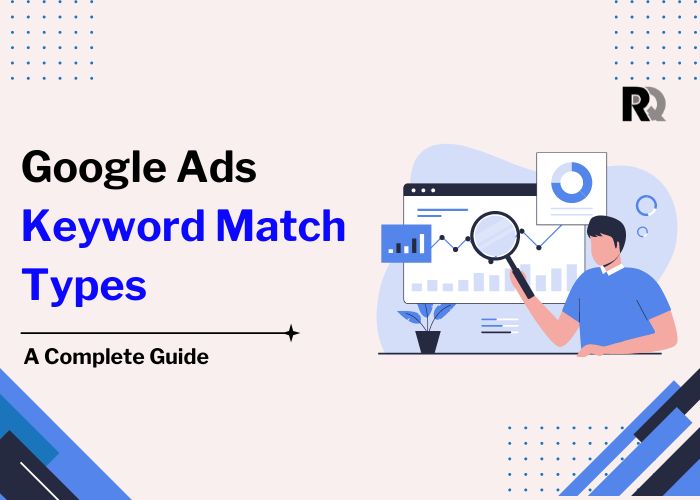If you are doing Google Ads keyword match types online advertising, you definitely need to understand google ads keyword match types. Without understanding this, you may be squandering your budget and missing your target audience.
In this post, I will simplify google ads keyword match types with examples and provide you with valuable tips and best practices that can help you plan, launch, and grow your google ads campaigns successfully.
So why don’t we go deeper into it and see how google ads keyword match types work.
Table of Contents

What Are Keyword Match Types in Google Ads?
Google ads keyword match types let you have more control regarding when your advertising shows up for the search terms people use.
You are effectively telling it: “Google, only allow my ad to appear when the search is the same or very similar to my keyword/s”.
In google ads, there are generally three types of keywords match:
- Broad Match
- Phrase Match
- Exact Match
When you add a keyword to your ad group, the match type is set to broad match by default. But default doesn’t mean the best.
Picking the right google ads keyword match types you use is critical since it will directly impact your cost per click, how many people see your search ad and the success of your overall ads performance.
The Difference Between Broad Match And Phrase Match
Let’s move onto broad match vs phrase match just because a lot of advertisers get tripped up here.
- Broad match means your ad could show for searches that are related to your keyword, even if those words aren’t exactly in the search. It’s useful to reach a broader base, but it can bring in irrelevant traffic.
- Phrase match: Your ad will appear when people search for the exact phrase of your keyword or very close variations. It’s more restrictive than broad match keyword.
Example: If your keyword is “buy shoes online”:
- With broad match, you could appear for the search “best shoes for running.” (even though jogging is not buying!)
- Phrase match will show your ad when someone searches for “buy shoes online” or similar phrases like “buy shoes online cheap.”
So the real decision is choosing between Broad Match vs Phrase Match carefully.
Learning about google ads keyword match types properly helps you save money and get quality clicks.
3. Exact Match Keyword Examples and Why They Matter
Many times, advertisers prefer exact match because it gives the most control. Let’s look at some exact match keyword examples.
Suppose your exact match keyword is [buy mobile phone].
Now, your ad could show only if someone types exactly “buy mobile phone” or close variations like “buy mobile phones” (plural).
It won’t show if someone types “buy second-hand mobile” — because the search intent is different!
Hence the importance of understanding exact match keyword examples while learning google ads keyword match types.
If you want better landing pages conversions and high-quality organic traffic, use exact match wisely.
4. How to Use Negative Keywords on Google Ads The Right Way
Knowing how to use negative keywords in google ads is very important too.
Negative keywords prevent your ad from being triggered by unwanted search queries.
Example: If you sell luxury laptops, you would want to avoid showing your ad when someone searches for “cheap laptops.”
Here, “cheap” would be your negative keyword.
Adding negative keywords reduces your cost per click and improves your ad’s relevance to your products or services, leading to better ads performance.
Whenever you are setting up your google ads keyword match types, don’t forget to also make a list of negative keywords. Trust me, it will save you a lot of money!
5. Best Practices for Google Ads Keyword Match Types
Here’s a simple and easy google ads match type guide you can follow for your next campaign:
- Broad match type: Use it when you want to discover new keywords and reach more people. Keep checking the search volume and what kinds of searches are triggering your ads.
- Phrase match keyword: A good choice if you know what your customers want but still want some flexibility.
- Exact match: Best for controlling your spending and targeting the most relevant search queries.
- Negative keywords: Super important! Add them after checking your search terms report.
Other tips to remember:
- Combine your match types with smart bidding to get better results.
- Create separate ad groups for each match type to keep your campaigns organised.
- Test different match types and monitor the ads performance.
Reading a good google ads keyword match types tutorial or studying real google ads keyword match types examples can help you avoid common mistakes.
Remember, understanding google ads keyword match types explained properly is the secret to running a winning google ads campaign.
Final Thoughts on Google Ads Keyword Match Types
In short, mastering google ads keyword match types can decide the success or failure of your online advertising.
Whether you use broad match, phrase match, or exact match depends entirely on your business goals — whether you want maximum reach or high precision.
Use this simple google ads keyword match types list:
- Broad for exploring
- Phrase for balance
- Exact for precision